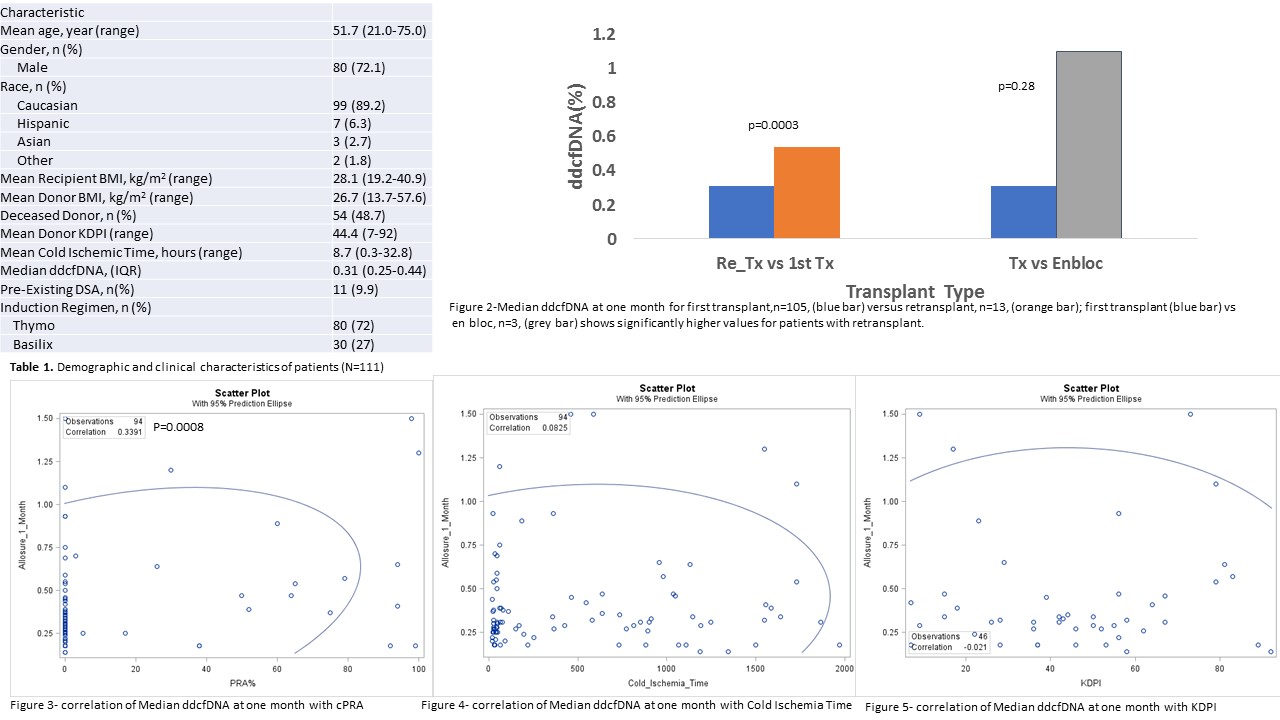Donor-Derived Cell-Free DNA Kinetics in Stable Kidney Transplant Patients Are Related to Donor/Recipient Variables
Intermountain Medical Center, Murray, UT
Meeting: 2020 American Transplant Congress
Abstract number: D-276
Keywords: Kidney
Session Information
Session Name: Poster Session D: Biomarkers, Immune Assessment and Clinical Outcomes
Session Type: Poster Session
Date: Saturday, May 30, 2020
Session Time: 3:15pm-4:00pm
 Presentation Time: 3:30pm-4:00pm
Presentation Time: 3:30pm-4:00pm
Location: Virtual
*Purpose: Donor-derived cell free DNA (dd-cfDNA) is increasingly used to monitor for allograft rejection. The relationship of dd-cfDNA to donor and recipient variables in not well described. We studied impact of donor and recipient variables on dd-cfDNA.
*Methods: Serial dd-cfDNA samples were obtained in the context of routine clinical care at months 1,2,3,4, 6, 9 and 12 months post-transplant in the 1st year post-transplant and every three months thereafter. Patients with biopsy proven acute rejection (BPAR) were excluded from the analysis. We compared the previous reported coefficient of variation (CV) 6.8% with our center’s intra-individual (CVI) and inter-individual (or group, CVG), coefficients of variation, and the reference change value (RCV).
*Results: In 111 patients: mean age: 51.7 years, 72% ;males, 89% ;Caucasian, and 48.7% ; deceased donor kidney transplants (Table 1). The means for cold ischemia time (CIT), Kidney Donor Profile (KDPI), Calculated Panel Reactive Antibody (cPRA) were 8.7 hours, 44.4%, and 13.6% respectively. Donor or recipient BMI, age, primary disease had no correlation with dd-cfDNA. Median dd-cfDNA at one month were not significantly different amongst donation after cardiac death, donation after brain death, living related and living unrelated donors (0.32, 0.32,0.31,0.27 ). Median dd-cf DNA at one month for patients with re-transplants (n=13) were significantly higher than first transplant (n=105) (p=0.0003), but not for en-bloc kidneys (n=3). (Figure 1). dd-cfDNA was positively correlated with cPRA (p=0.0008), but not with CIT and KDPI (Figure 2,3,4). Thymoglobulin induction was associated with higher median dd-cfDNA at one month compared to basiliximab induction (p=0.015). Of the 551 blood samples, dd-cfDNA values were less than 0.5% for 494 (89.6%) blood draws, 41(7.5%) were >0.5% – 1%, and 16 (2.9%) were >1% . In the 57 patients with detectable measurements for dd-cfDNA, the CVI was 30.04%, CVG was 66.5%, and RCV was 141%.
*Conclusions: Contrary to expectations, our study shows that CIT, KDPI do not have a bearing on dd-cfDNA at one month. Patients with retransplants have a significantly higher dd-cfDNA when compared to first transplants. Our reference range for dd-cfDNA in stable kidney transplants is similar to previous studies. Our RCV points out that in stable kidney transplant population, a serial increase of less than 141% in dd-cfDNA may be attributable to biological variation, whereas greater changes may be of significance. Donor and recipient characteristics and cPRA may inform cut off values prospectively.
To cite this abstract in AMA style:
Anand S, Dong L, Dow S, Fife M, Krong J, Morris D, Srinivas T. Donor-Derived Cell-Free DNA Kinetics in Stable Kidney Transplant Patients Are Related to Donor/Recipient Variables [abstract]. Am J Transplant. 2020; 20 (suppl 3). https://atcmeetingabstracts.com/abstract/donor-derived-cell-free-dna-kinetics-in-stable-kidney-transplant-patients-are-related-to-donor-recipient-variables/. Accessed July 18, 2025.« Back to 2020 American Transplant Congress

